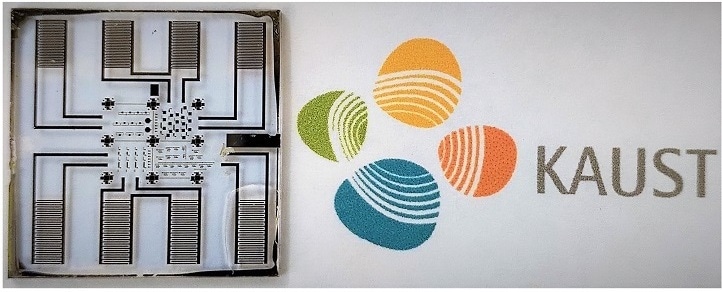Jul 29 2019
Being able to integrate multiple functions into a single microchip is a noteworthy breakthrough in the mission to refine the miniature, self-powered sensors that will progress the Internet of Things. KAUST scientists have successfully combined energy-harvesting, sensing, current-rectifying, and energy-storage operations into one microchip.
 A thin-film chip with the energy-storing microsupercapacitors arrayed along top and bottom of the chip. (Image credit: © 2019 KAUST)
A thin-film chip with the energy-storing microsupercapacitors arrayed along top and bottom of the chip. (Image credit: © 2019 KAUST)
Previously, researchers had to use bulky rectifiers that converted intermittent harvested electrical energy into steady direct current for storage in electrochemical microsupercapacitors.
Mrinal K. Hota, Study Lead Author and Research Scientist, KAUST
Hota describes that the way to combine everything into one chip was using ruthenium oxide (RuO2) as the common electrode material linking all devices in the microcircuits. The team visualizes a wide variety of applications from checking personal health indicators directly from the human body to industrial and environmental sensing.
Our achievement simplifies device fabrication and realizes significant miniaturization of self-powered sensor devices.
Mrinal K. Hota, Study Lead Author and Research Scientist, KAUST
The RuO2 contacts are placed onto a silicon or glass substrate to connect energy-harvesting, sensing, and current-rectifying electronics with one or more electrochemical microsupercapacitors that can store the electrical energy. This forms a miniature system that can run without any battery power. In its place, it uses available machinery vibrations or body movement as the dependable and constant source of energy.
“Unlike a battery, electrochemical microsupercapacitors can last for hundreds of thousands of cycles rather than just a few thousand,” Hota highlights. They can also deliver a considerably higher power output from a particular volume.
The solution to creating an electrode material that is suitable for connecting all devices was to make optimal ruthenium-dioxide surfaces having defects, controlled roughness, and conductivity. These features allowed the team to use RuO2 for both electrochemical microsupercapacitors and electronics.
Another vital breakthrough was to use a gel that, after application, hardens into the supercapacitors’ electrolyte. This is a material that conveys electric charge in the form of ions. The solidified gel was used to avert any damage to thin-film transistors and rectifiers.
The team currently aims to work to further enhance the RuO2 electrodes and investigate linking many diverse types of sensors into their chips. They also want to explore incorporating wireless communication into the device. This would enable environmental sensors and biosensors to transmit data remotely to any wireless receivers, such as personal computers and mobile phones.
The research team, guided by Prof. Husam Alshareef, also includes KAUST’s Prof. Khaled Salama and Prof. Z.L. Wang from the Georgia Institute of Technology in Atlanta, USA.